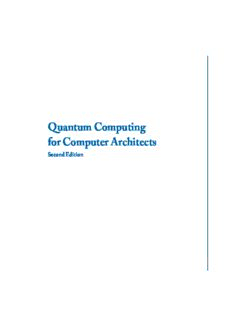
Quantum Computing for Computer Architects (Synthesis Lectures on Computer Architecture) PDF
Preview Quantum Computing for Computer Architects (Synthesis Lectures on Computer Architecture)
Quantum Computing for Computer Architects SecondEdition Synthesis Lectures on Computer Architecture Editor MarkD.Hill,UniversityofWisconsin SynthesisLecturesonComputerArchitecturepublishes50-to100-pagepublicationsontopics pertainingtothescienceandartofdesigning,analyzing,selectingandinterconnectinghardware componentstocreatecomputersthatmeetfunctional,performanceandcostgoals.Thescopewill largelyfollowthepurviewofpremiercomputerarchitectureconferences,suchasISCA,HPCA, MICRO,andASPLOS. QuantumComputingforComputerArchitects,SecondEdition TzvetanS.Metodi,ArvinI.Faruque,andFredericT.Chong 2011 ProcessorMicroarchitecture:AnImplementationPerspective AntonioGonzález,FernandoLatorre,andGrigoriosMagklis 2010 TransactionalMemory,2ndedition TimHarris,JamesLarus,andRaviRajwar 2010 ComputerArchitecturePerformanceEvaluationMethods LievenEeckhout 2010 IntroductiontoReconfigurableSupercomputing MarcoLanzagorta,StephenBique,andRobertRosenberg 2009 On-ChipNetworks NatalieEnrightJergerandLi-ShiuanPeh 2009 TheMemorySystem:YouCan’tAvoidIt,YouCan’tIgnoreIt,YouCan’tFakeIt BruceJacob 2009 iii FaultTolerantComputerArchitecture DanielJ.Sorin 2009 TheDatacenterasaComputer:AnIntroductiontotheDesignofWarehouse-ScaleMachines LuizAndréBarrosoandUrsHölzle 2009 ComputerArchitectureTechniquesforPower-Efficiency StefanosKaxirasandMargaretMartonosi 2008 ChipMultiprocessorArchitecture:TechniquestoImproveThroughputandLatency KunleOlukotun,LanceHammond,andJamesLaudon 2007 TransactionalMemory JamesR.LarusandRaviRajwar 2006 QuantumComputingforComputerArchitects TzvetanS.MetodiandFredericT.Chong 2006 Copyright© 2011byMorgan&Claypool Allrightsreserved.Nopartofthispublicationmaybereproduced,storedinaretrievalsystem,ortransmittedin anyformorbyanymeans—electronic,mechanical,photocopy,recording,oranyotherexceptforbriefquotationsin printedreviews,withoutthepriorpermissionofthepublisher. QuantumComputingforComputerArchitects,SecondEdition TzvetanS.Metodi,ArvinI.Faruque,andFredericT.Chong www.morganclaypool.com ISBN:9781608456192 paperback ISBN:9781608456208 ebook DOI10.2200/S00331ED1V01Y201101CAC013 APublicationintheMorgan&ClaypoolPublishersseries SYNTHESISLECTURESONCOMPUTERARCHITECTURE Lecture#13 SeriesEditor:MarkD.Hill,UniversityofWisconsin SeriesISSN SynthesisLecturesonComputerArchitecture Print1935-3235 Electronic1935-3243 Quantum Computing for Computer Architects SecondEdition Tzvetan S.Metodi TheAerospaceCorporation Arvin I.Faruque UniversityofCalifornia,SantaBarbara FredericT.Chong UniversityofCalifornia,SantaBarbara SYNTHESISLECTURESONCOMPUTERARCHITECTURE#13 M &C Morgan &cLaypool publishers ABSTRACT Quantum computers can (in theory) solve certain problems far faster than a classical computer runninganyknownclassicalalgorithm.Whileexistingtechnologiesforbuildingquantumcomputers are in their infancy,it is not too early to consider their scalability and reliability in the context of thedesignoflarge-scalequantumcomputers.Toarchitectsuchsystems,onemustunderstandwhat it takes to design and model a balanced, fault-tolerant quantum computer architecture.The goal ofthislectureistoprovidearchitecturalabstractionsforthedesignofaquantumcomputerandto explorethesystems-levelchallengesinachievingscalable,fault-tolerantquantumcomputation. Inthislecture,weprovideanengineering-orientedintroductiontoquantumcomputationwith anoverviewofthetheorybehindkeyquantumalgorithms.Next,welookatarchitecturalcasestudies baseduponexperimentaldataandfutureprojectionsforquantumcomputationimplementedusing trappedions.Whilewefocushereonarchitecturestargetedforrealizationusingtrappedions,the techniques for quantum computer architecture design, quantum fault-tolerance, and compilation described in this lecture are applicable to many other physical technologies that may be viable candidates for building a large-scale quantum computing system. We also discuss general issues involved with programming a quantum computer as well as a discussion of work on quantum architecturesbasedonquantumteleportation.Finally,weconsidersomeoftheopenissuesremaining inthedesignofquantumcomputers. KEYWORDS quantum computing,computer architecture,fault tolerance,error correction,trapped ions, teleportation, qubit, quantum logic array, quantum simulation, quantum algo- rithms vii Contents Preface .................................................................. xi 1 Introduction ..............................................................1 2 BasicElementsforQuantumComputation ..................................7 2.1 Classicalvs.QuantumSignalStates(bitsvs.qubits) ......................... 7 2.2 LogicOperationsandCircuits............................................ 8 2.3 QuantumMeasurement ................................................ 13 2.4 Example:The3-QubitQuantumToffoliGate ............................. 15 2.5 Example:QuantumFourierTransform(QFT) ............................. 16 2.6 Example:QuantumTeleportation........................................ 17 2.7 Example:Deutsch’sQuantumAlgorithm ................................. 17 2.8 QuantumEntanglementandEPRPairs .................................. 19 2.9 OtherModelsofQuantumComputation ................................. 21 3 KeyQuantumAlgorithms ................................................ 23 3.1 QuantumIntegerFactorization .......................................... 23 3.1.1 TheIntegerFactorizationProblem................................. 23 3.1.2 AQuantumIntegerFactorizationAlgorithm ........................ 24 3.1.3 QuantumIntegerFactorization:ProofofClassicalPart ............... 25 3.2 OrderFinding ........................................................ 25 3.2.1 OrderFindingasQuantumEigenvalueEstimation................... 27 3.2.2 OrderFinding:ContinuedFractions ............................... 29 3.3 QuantumPhaseEstimation ............................................. 31 3.3.1 ProofSketchoftheCorrectnessofthePhaseEstimationCircuit ....... 31 3.4 EigenvalueEstimation ................................................. 34 3.5 TheHiddenSubgroupProblem.......................................... 36 3.6 Grover’sAlgorithmforQuantumSearch.................................. 38 3.6.1 SearchingwithaQuantumBlackBox .............................. 39 3.6.2 Grover’sAlgorithm .............................................. 39 3.6.3 ProofSketchoftheCorrectnessofGroverIteration .................. 40 viii 3.7 QuantumAdiabaticAlgorithms ......................................... 44 3.7.1 3-SAT:AnexampleofaQuantumAdiabaticalgorithm ............... 46 4 BuildingReliableandScalableQuantumArchitectures...................... 49 4.1 Reliableandrealisticimplementationtechnology ........................... 51 4.1.1 OpticalQuantumComputation:PhotonsasQubits .................. 53 4.1.2 Trapped-IonQuantumComputation:IonsasQubits ................. 54 4.2 RobustErrorCorrectionandFault-TolerantStructures...................... 57 4.2.1 NoiseModelAssumptions........................................ 58 4.2.2 ErrorCorrection:BasicsandNotation.............................. 61 4.2.3 Example:TheSteane[[7,1,3]]Code ............................... 67 4.2.4 LogicalQubitsinQuantumComputation .......................... 71 4.2.5 QuantumErrorCorrectionandFault-Tolerance:TheThresholdResult . 72 4.2.6 TheCostofQuantumErrorCorrection ............................ 75 4.2.7 Scale-UpinSystemSizeduetoErrorCorrection .................... 75 4.2.8 ErrorCorrectionSlowdown....................................... 76 4.3 QuantumResourceDistribution ......................................... 79 4.3.1 PhysicalQubitMovement ........................................ 80 4.3.2 Teleportation-BasedCommunicationandQuantumRepeaters......... 81 5 SimulationofQuantumComputation ..................................... 85 5.1 SimulationofErrorPropagation ......................................... 86 5.2 StabilizerMethodforQuantumSimulation ............................... 89 6 ArchitecturalElements .................................................. 91 6.1 QuantumProcessingElements(PE’s) .................................... 93 6.2 QuantumMemoryHierarchy ........................................... 94 6.3 QuantumAddressingSchemeforClassicalMemory........................ 97 6.4 ErrorCorrectionandQuantumArchitectureDesign........................ 99 6.4.1 EffectsofAncillaPreparationandLayout........................... 99 6.4.2 OptimizingErrorCorrectionalongCriticalPaths ................... 101 7 CaseStudy:TheQuantumLogicArrayArchitecture ....................... 103 7.1 QLAArchitectureOverview ........................................... 103 7.2 TheLogicalQubitDesignintheQLA .................................. 105 7.3 LogicalQubitInterconnect ............................................ 107 7.4 CompressedQLAArchitecture:CQLA ................................. 117 ix 7.4.1 TheGainProduct:ArchitecturePerformanceComparison ........... 120 7.4.2 CommunicationIssues:ExecutingtheToffoliGate.................. 120 7.4.3 MemoryHierarchyintheCQLAArchitecture ..................... 122 7.4.4 SimulatingtheCacheintheCQLA............................... 124 7.5 Qualypso ............................................................ 126 8 ProgrammingtheQuantumArchitecture ................................. 129 8.1 Physical-LevelInstructionScheduling ................................... 130 8.2 High-LevelCompilerDesign .......................................... 132 8.3 Architecture-IndependentCircuitSynthesis .............................. 133 8.4 MappingCircuitstoArchitecture ....................................... 134 8.5 OptimizationoftheLogicalQubitTiles ................................. 138 8.5.1 TheFault-TolerantThresholdEstimates ........................... 138 8.5.2 CircuitSchedulingandTheFault-ToleranceConstraint.............. 140 8.5.3 ThresholdCalculations.......................................... 143 8.5.4 SummaryDiscussion............................................ 145 9 UsingtheQLAforQuantumSimulation:TheTransverseIsingModel ....... 149 9.1 TheTransverseIsingModelOverview ................................... 149 9.2 TIMQuantumSimulationResourceEstimates ........................... 150 9.2.1 Phaseestimationcircuit ......................................... 150 9.2.2 DecompositionoftheTIMquantumcircuitintofault-tolerantgates ... 152 9.3 MappingtheTIMcircuitontotheQLAarchitecture ...................... 155 9.3.1 Resourceestimatesforthe1-DTIMproblem ...................... 156 10 Teleportation-BasedQuantumArchitectures.............................. 159 10.1 ThecnotGateandSingle-QubitGatesthroughTeleportation ............. 161 10.2 TheArchitecture ..................................................... 163 10.3 ErrorCorrectionthroughTeleportation.................................. 166 11 ConcludingRemarks ................................................... 169 Bibliography........................................................... 171 Authors’Biographies ................................................... 191
Description: